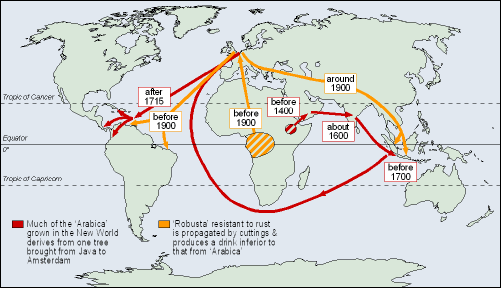Today coffee is produced all over the world, from Central to Northern Africa to the Philippines and the Americas. The plant native to the Ethiopian Plateau grows in exclusively tropical environments with in 20 degrees north and south of the equator and prefers elevation of 1,600-3,600 feet. In environments within 10 degrees of the equator coffee prefers elevation ranges of 3,600-6,300 feet, these environments are prized for producing especially tasty cups of coffee. This is because the growth cycles are slowed resulting in cherries with more mucilage around the beans; producing a more acidic, sweet and flavorful cup of coffee. A healthy plant enjoys 60-80 inches of water a year with intermittent dry seasons. The plants also like a constant temperature of about 70 degrees Fahrenheit in partial to full sun. In full sun coffee plants may be susceptible nitrogen deficiency because a shade plant in full sun require more nutrients to juggle of balancing all the nutrients it needs for the sun it receives, full sun also means the forest floor is more exposed and more likely to be eroded. Soils ideal for coffee would be slightly acidic (arabica can grow in 4-7 on pH scale) and high in nitrogen. A good site also needs decent drainage because the plants are susceptible to root rot, but the ground must also be able to hold water deep enough to provide water to the plant in the dry seasons.
The coffee in peoples cups today are mostly likely of two varieties; Arabica and Robusta. The difference in the two trees and beans while morphologically minuscule mean a world of difference in the industry. Over all the Arabica plant is preferred because its believed to produce a better cup of coffee than Robusta, and so it makes up more than 70% of the world coffee production. The differences in the two varieties become crucial when talking about geography because Arabica is just more fragile than Robusta. Robusta’s name seems to fit it perfectly, at least in terms of its preferred conditions as it tolerates higher temperature, less precipitation and is more disease/pest resistant than its relative.

(Batdorf & Bronson “What is Specialty Coffee”)

